| 16 September |
• yesterday • tomorrow |
| Memorial of Saint Cornelius, pope and martyr, and Saint Cyprian, bishop and martyr |
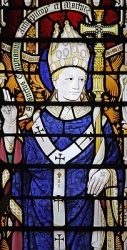
• Thaschus Caecilius Cyprianus
• Thascius Caecilius Cyprian
Born to wealthy pagan parents. Taught rhetoric and literature. Adult convert in 246, taught the faith by Saint Caecilius of Carthage. Ordained in 247. Bishop of Carthage in 249. During the persecution of Decius, beginning in 250, Cyprian lived in hiding, covertly ministering to his flock; his enemies condemned him for being a coward and not standing up for his faith. As a writer he was second only in importance to Tertullian as a Latin Father of the Church. Friend of Saint Pontius. Involved in the great argument over whether apostates should be readmitted to the Church; Cyprian believed they should, but under stringent conditions. Supported Pope Saint Cornelius against the anti-pope Novatian. During the persecutions of Valerian he was exiled to Curubis in 257, brought back Carthage, and then martyred in 258. His name is in the Communicantes in the Canon of the Mass.
190 in Carthage, North Africa
beheaded 14 September 258 in Carthage, North Africa
• Algeria (proclaimed on 6 July 1914 by Pope Pius X)
• North Africa (proclaimed on 6 July 1914 by Pope Pius X, on 10 January 1958 by Pope Pius XII, and on 27 July 1962 by Pope John XXIII editor's note - no, I don't know why it was done so many times)
You cannot have God for your Father if you do not have the Church for your mother.... God is one and Christ is one, and his Church is one; one is the faith, and one is the people cemented together by harmony into the strong unity of a body.... If we are the heirs of Christ, let us abide in the peace of Christ; if we are the sons of God, let us be lovers of peace. - Saint Cyprian, from The Unity of the Catholic Church
Whatever a man prefers to God, that he makes a god to himself. - Saint Cyprian
Let us remember one another in concord and unanimity. Let us on both sides of death always pray for one another. Let us relieve burdens and afflictions by mutual love, that if one of us, by the swiftness of divine condescension, shall go hence the first, our love may continue in the presence of the Lord, and our prayers for our brethren and sisters not cease in the presence of the Father's mercy. - Saint Cyprian from Letters, 253
On the morning of the 14th of September, a great crowd gathered at the Villa Sexti, in accordance with the order of the governor Galerius Maximus. That same day the governor commanded Bishop Cyprian to be brought before him for trial. After Cyprian was brought in, the governor asked him, "Are you Thascius Cyprian?" The bishop replied, "Yes, I am." The governor Galerius Maximus said, "You have set yourself up as an enemy of the gods of Rome and our religious practices. You have been discovered as the author and leader of these heinous crimes, and will consequently be held forth as an example for all those who have followed you in your crime. By your blood the law shall be confirmed." Next he read the sentence from a tablet. "It is decided that Cyprian should die by the sword." Cyprian responded, "Thanks be to God!" After the sentence was passed, a crowd of his fellow Christians said, "We should also be killed with him!" There arose an uproar among the Christians, and a great mob followed after him. Cyrprian was then brought out to the grounds of the Villa Sexti, where, taking off his outer cloak and kneeling on the ground, he fell before the Lord in prayer. He removed his dalmatic and gave it to the deacons, and then stood erect while waiting for the executioner. When the executioner arrived, Cyprian told his friends to give the man 25 gold pieces. The most Blessed martyr Cyprian suffered on the 14th of September under the emperors Valerian and Gallienus, in the reign of our true Lord Jesus Christ, to whom belong honor and glory for ever. Amen. - from the Acts of the Martyrdom of Saint Cyprian by Saint Pontius
You who are envious, let me tell you that however often you may seek for the opportunity of injuring him whom you hate, you will never be able to do him so much harm as you do harm to yourselves. He whom you would punish through the malice of your envy, may probably escape, but you will never be able to fly from yourselves. Wherever you may be your adversary is with you, your sin rankles within. It must be a self-willed evil to persecute a person whom God has taken under the protection of His grace; it becomes an irremedial sin to hate a man whom God wishes to make happy. Envy is as prolific as it is hurtful; it is the root of all evil, the source of endless disorder and misery, the cause of most sins that are committed. Envy gives birth to hatred and animosity. From it avarice is begotten, for it sees with an evil eye honors and emoluments heaped upon a stranger, and thinks that such honors should have been, by right, bestowed upon himself. From envy comes contempt of God, and of the salutary precepts of our Savior. The envious man is cruel, proud, unfaithful, impatient, and quarrelsome; and, what is strange, when this vice gains the mastery, he is no longer master of himself, and he is unable to correct his many faults. If the bond of peace is broken, if the rights of fraternal charity are violated, if truth is altered or disguised, it is often envy that hurries him on to crime. What happiness can such a man enjoy in this world? To be envious or jealous of another, because such a one is virtuous and happy, is to hate in him the graces and blessings God has showered down upon him. Does he not punish himself when he sees the success and welfare of others? Does he not draw down upon himself tortures from which there is no respite? Are not his thoughts, his mind, constantly on the rack? He pitilessly punishes himself, and, in his heart, performs the same cruel office which Divine Justice reserves for the chastisement of the greatest criminal. - Saint Cyprian
https://catholicsaints.info/saint-cyprian-of-carthage/
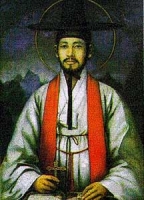
• Andrew Kim
• Andreas Kim Tae-Gon
• Andeurea Gim Dae-Geon
Born to the Korean nobility; his parents were converts to Christianity, and his father was martyred. Andrew was baptized at age 15, then travelled 1,300 miles to the nearest seminary in Macao, China. While still in seminary, he travelled back to Korea to work in the missions, travelling with Saint Marie-Nicolas-Antoine Daveluy. Ordained in Shanghai on 17 August 1845 by Bishop Jean-Joseph-Jean-Baptiste Ferréol who was en route to Korea as its new Vicar Apostolic. Father Andrew became the first native Korean priest, and the first priest to die for the faith in Korea. Leader of the Martyrs of Korea.
21 August 1821, Solmoi, Chungcheong-do, South Korea
tortured and beheaded on 16 September 1846 at Saenamteo, Seoul, Korea
6 May 1984 by Pope John Paul II
Korean clergy
The Korean Church is unique because it was founded entirely by laypeople. This fledgling Church, so young and yet so strong in faith, withstood wave after wave of fierce persecution. Thus, in less than a century, it could boast of 10,000 martyrs. The death of these many martyrs became the leaven of the Church and led to today's splendid flowering of the Church in Korea. Even today their undying spirit sustains the Christians of the Church of Silence in the north of this tragically divided land. - Pope John Paul II at the canonization of Andrew in 1984
O God, You have created all nations and You are their salvation. In the land of Korea Your call to Catholic faith formed a people of adoption, whose growth You nurtured by the blood of Andrew, Paul and their companions. Through their martyrdom and their intercession grant us strength that we too may remain faithful to your commandments even until death. Amen.
https://catholicsaints.info/saint-andrew-kim-taegon/
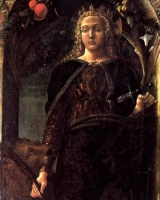
Born to a wealthy, aristocratic, and pious family; the daughter of Philophorm and Theodosia, Christians in a pagan world. Consecrated virgin who used her fortune to aid the poor. Ordered to sacrifice to a statue of Ares, she refused. She was imprisoned and tortured, but repeatedly was miraculously healed. When her example had strengthened her companions and converted all of the pagans who would listen, include Saint Sosthenes and Victor, she died. Martyr.
c.290 at Chalcedon, Asia Minor
• tortured, then thrown to wild beasts c.305 at Chalcedon, Asia Minor
• interred in Chalcedon, and a church built over her remains
• relics were brought to the Council of Chalcedon in 451; many miraculous healings occurred, orthodox Christianity was defended, and the Monophysite heresy suppressed
• relics translated to the Saint George Church in the Ecumenical Patriarchate, Constantinople c.620 when Chalcedon was attacked by the Persians
• relics thrown into the sea in the late 8th century by iconoclasts
• relics recovered by pious sailors and returned to Constantinople in 796
• Rovinj, Croatia, claims to have miraculously received at least part of her relics
• Alba Adriatica, Italy
• Rovinj, Croatia
• with a lion
• with a bear
• with snakes
• stabbed with a sword
• holding a lily and palm
We are people endowed with reason, for whom it would be the greatest disgrace to abandon the one true God, the Maker of heaven and earth, in order to worship dumb, senseless idols. We are not afraid of torments you threaten us with. They will be easy for us to bear and will show the power of our God. - Saint Euphemia to Proconsul Priscius when ordered to sacrifice to a statue
https://catholicsaints.info/saint-euphemia-of-chalcedon/
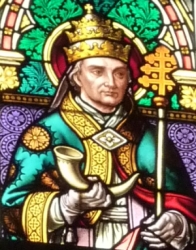
Bishop. Reluctant 21st pope, elected after a year-and-a-half period during which the persecutions were so bad that papal ascension was a quick death sentence.
Worked to maintain unity in a time of schism and apostasy. Fought Novatianism and called a synod of bishops to confirm him as rightful pontiff, as opposed to the anti-pope Novatian. Had the support of Saint Cyprian of Carthage and Saint Dionysius. He welcomed back those who had apostacized during the persecutions of Decius; the documents that settled this matter prove the final authority of the Pope. Exiled to Centemcellae in 252 by Roman authorities to punish Christians in general, who were said to have provoked the gods to send plague against Rome. Martyr.
A document from Cornelius shows the size of the Church in Rome in his papacy: 46 priests, 7 deacons, 7 subdeacons, approximately 50,000 Christians.
251
• martyred in 253
• buried at the cemetery of Saint Callistus at Rome, Italy
battle horn
• against earache; earache sufferers
• epileptics; against epilepsy
• against fever
• against twitching
• cattle
• domestic animals
• Kornelimünster, Germany
• pope holding a battle horn or cow's horn
• pope with a cow nearby
https://catholicsaints.info/pope-saint-cornelius/
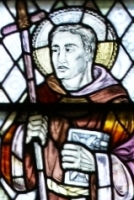
• Apostle of North Britain
• Apostle of the Picts
• Dinan, Ninias, Ninianus, Ninus, Nynia, Ninyas, Ringan, Ringen
Son of a chieftain of the Cumbrian Britons. His father was a convert to Christianity, and Ninian was raised a Christian. Studied in Rome, Italy for fifteen years under the direction of Pope Saint Damasus I. Priest. Bishop, consecrated by Pope Saint Siricus c.394. Friend of Saint Martin of Tours. Returned home to evanglize his region, working with the Britons and Picts, and helping lay a solid foundation for the Church in Scotland. With help from masons from Saint Martin's abbey, Ninian built his great monastery, the White House c.397, so called because the stone work was unusual in an era of wooden churches. It was probably the first Christian settlement in Scotland, became the centre of his work, is now known as Whithorn Abbey, and is one of the holiest places in that country. Miracle worker, known to have cured a neighboring chieftain of blindness. Saint Aelred wrote a biography of him, and Saint Bede mentions him in the history of early evangelization in the Isles. His tombs, and a nearby cave where he used to retreat for prayer and meditation, are still places of pilgrimage.
c.360 at Cumbria, Britain
• c.432 of natural causes
• interred at the church at Whithorn Abbey, Scotland
• relics lost during the Reformation
• Antigonish, Nova Scotia, Canada, diocese of
• Galloway, Scotland, diocese of
bishop with crozier and book
https://catholicsaints.info/saint-ninian/

• Louis Alamanus
• Louis Alemanus
• Louis Almannus
• Louis Alamandus
Born to the French nobility. Canon lawyer. Bishop of Maguelonne, France in 1418. Advisor, courtier and diplomat in service to Pope Martin V. Archbishop of Arles, France in 1423. Created Cardinal-priest of Sante Cecilia in 1426. Important member of the Council of Basle in 1436, leading the party that maintained the supremacy of general councils over the pope, and working to forward the decree of the Immaculate Conception of Our Lady. While he was there he worked with victims of a plague outbreak.
In 1439, in a misguided attempt at Church reform, Allemand was primarily responsible for the election of Anti-Pope Felix V, which led to Pope Eugenius IV excommuniting them both. Allemand consecrated Felix as bishop, then crowned him as pope, and served as a papal diplomat. He was also primarily responsible for ending the schism by convincing Felix to abdicate. Pope Nicholas V was elected; he restored Allemand to all his honours and offices, and made him papal legate to Germany in 1449.
Vatican politics aside, Allemand was always know for his strong faith, personal piety, and as dedicated shepherd of his dioceses.
c.1380 in Arbent castle, diocese of Belley, France
16 September 1450
1527 by Pope Clement VII (cultus confirmation)
https://catholicsaints.info/blessed-louis-allemand/
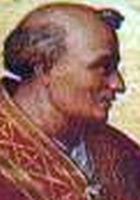
Daufar, Dauferius, Desiderius
Son of Prince Landolfo V of Benevento, Italy. He felt an early call to religious life, but as he was the only son, his family opposed his vocation. He fled an arranged marriage, was brought back by force, and escaped again; his family finally gave in. Monk at San Sophia monastery, Benevento, taking the name Desiderius. Monk at Monte Cassino at age 30. Abbot of Monte Cassino. Cardinal in 1059. Worked closely with Pope Saint Gregory VII. Chosen 158th pope in 1086; he was so reluctant to accept that his coronation didn't take place for nearly a year, and then he retreated to Monte Cassino. Countess Matilda of Tuscany convinced him to return to Rome, Italy, but because of the strength of force of anti-pope Clement III he soon fled again. In August 1087 he held a synod at Benevento which excommunicated Clement III, forbade lay investiture, and proclaimed a Crusade against the Saracens in Africa.
1027 in Benevento, Italy as Dauterius
• elected 24 May 1086
• enthroned 9 May 1087
• 16 September 1087 at the monastery of Monte Cassino, Italy of natural causes
• buried at Monte Cassino
23 July 1887 by Pope Leo XIII
https://catholicsaints.info/pope-blessed-victor-iii/
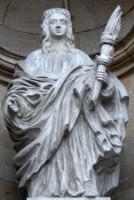
• Ephemia of Ourense
• Eufemia...
We have no information about the life, nor specifics about the death of this martyr. Tradition says that her relics were miraculously found by a Spanish shepherdess in the late 11th century. Devotion began immediately due to the miraculous healings caused by the intercession of Saint Euphemia. To fill in the gaps in ther story, beginning in the 16th century there were many “lives” written about her, and many of them confuse her with Saint Euphemia of Chalcedon, but no real information about the life of this Saint Euphemia has survived.
• relics re-discovered in the late 11th century near the Spanish–Portuguese border
• relics enshrined under the altar in an small church dedicated to Saint Marina near where they had been found
• relics transferred to the cathedral in Orense, Spain by Bishop Pedro Seguin c.1163
• relics re-enshrined with those of Saint Facondo and Saint Primitivo on 23 June 1720 by Bishop Juan Munoz de la Cueva
https://catholicsaints.info/saint-euphemia-of-orense/
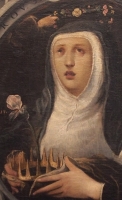
Eadgyth, Eadgith, Editha, Ediva
Daughter of King Edgar the Peaceable and Saint Wilfrida. Raised in the abbey in Wilton, England, which she never left. Educated at the royal court, learning to read, write, illuminate manuscripts, sew and embroider. Benedictine nun from age 15. Offered the position of abbess at three houses, and her father's throne, but she refused them all. Built the Saint Denis Church at Wilton. Had a gift for communicating with wild animals. Saint Dunstan nursed her during her fatal illness, having received a vision of her passing.
961 at Kensing, Kent, England
• 15 September 984, a date foretold by Saint Dunstan of Canterbury, of natural causes
• a week later she appeared in a vision to her mother, claiming to have smacked the devil in the head
Benedictine nun holding a book and with one hand raised
She did not leave the world; she never knew it. - Roman Martyrology
https://catholicsaints.info/saint-edith-of-wilton/
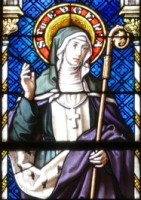
• Eugenia of Alsace
• Eugenia of Altitona
• Eugenia of Altodunum
• Eugénie
Born to the nobility, the daughter of Duke Adalbert of Alsace (in modern France; sister of Saint Attale. Niece of Saint Ottilia of Alsace. Nun. Abbess of Hohenburg Abbey on Mount Sainte Odille, Ottrott, Alsace, France from 721 till her death in 735. Eugenia was known for following the example of Saint Ottilia, and for leading by her own example.
• 735 at the Hohenburg Abbey, Mount Sainte Odille, Ottrott, Alsace, France of natural causes
• interred in the chapel of Saint John the Baptist near the tomb of Saint Odilla
• her tomb was destroyed by Swedish troops in 1622 during the Thirty Years War
• some relics, recovered by the sisters of the Abbey, were transferred to Oberehnheim, Alsace, France in 1622
• some relics later transferred to the parish church in Willgottheim, Alsace, France
https://catholicsaints.info/saint-eugenia-of-hohenburg/
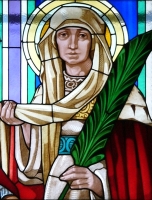
Ludmilla
Daughter of a Slavic prince. Duchess of Bohemia, married to Boriwoi, first Christian Duke of Bohemia; the two were baptized by Saint Methodius in 871. They built the first Christian church in Bohemia, and tried to force Christianity on their subjects; they failed. Widow. Grandmother and tutor of Saint Wenceslaus of Bohemia. Gave a proper burial to Saint Ivan. Her daughter-in-law, Drahomira, jealous of the influence which Ludmilla wielded over her grandson, Wenceslaus, had her murdered.
860 at Mielnik (in modern Poland)
• strangled by hired assassins at Tetin, Czech Republic on 15 September 921 on orders of her daughter-in-law due to her influence over Saint Wenceslaus
• relics at Saint George's Church, Prague, Czech Republic
• against in-law problems
• converts
• duchesses
• widows
• Bohemia
• Czech Republic
https://catholicsaints.info/saint-ludmila/
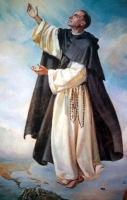
• Juan de Massias
• Juan Massias
• John....
• Arcas Sánchez
Born to a pious and impoverished Spanish noble family. Orphaned young, he worked as a shepherd. Worked on a South American cattle ranch around Cartagena, Colombia. Dominican lay brother at Lima, Peru, received by the house on 23 January 1622. Worked as porter or doorkeeper for his friary for over 20 years. Noted for visions, for his care for the poor of Lima, and for his endless praying of the Rosary, offering all his prayers for the release of souls in Purgatory; traditions says that he freed over a million through his prayers. Friend of Saint Martin de Porres.
2 March 1585 at Ribera del Fresno, Estramadura, Spain
16 September 1645 in Lima, Peru of natural causes
28 September 1975 by Pope Paul VI
https://catholicsaints.info/saint-juan-macias/
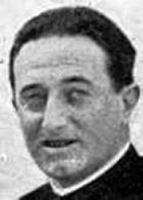
Ignasi of Saint Raymond
Son of Raimondo Casanovas Brunet and Maria Perramón Oliveras; he was baptized at the age of one day. Joined the Piarists on 21 November 1909, making his solemn vows on 30 August 1914. Ordained a priest on 17 September 1916. Worked in the Spanish cities of Terrassa, Vilanueva, Olot and Barcelona. Martyred in the Spanish Civil War.
21 June 1893 in Igualada, Barcelona, Spain
• shot on 16 September 1936 in a grove of trees near his mother‘s house in Odena, Barcelona, Spain
• buried in the city cemetery of Odena
• re-interred in the family tomb in Odena on 21 May 1948
1 October 1995 by Pope John Paul II
https://catholicsaints.info/blessed-ignasi-casanovas-perramon/
Priest in Rome, Italy. Arrested with Saint Abundantius for refusing to sacrifice to Hercules. Tortured at Mammertine prison, and condemned to death for their Christianity. On the way to execution the two passed Senator Marcian who was grieving over his son John who had just died. Abundius prayed over John, and the boy returned to life; Marcian and John converted to Christianity on the spot. Martyr.
beheaded c.304 at Rome, Italy
man bringing a dead boy back to life while other people, including guards, look on
https://catholicsaints.info/saint-abundius-the-priest/
Vitalis gave up wealth and a position in the landed gentry to become a hermit, monk and then abbot of 140 Benedictine brother monks at the monastery in Savigny, Normandy, France. Friend of Saint Robert of Arbrisselle. Vitalis successfully worked to evangelize the area around the monastery.
Tierceville, France
• died suddenly of natural causes while about to impart a blessing to a chorister in 1119
• relics enshrined in the French cities of Le Mans, Avranches and Rennes
https://catholicsaints.info/saint-vitalis-of-savigny/
Son of Saint Marcian the Senator. Died of unknown causes, but was brought back to life through the prayers of Saint Abundius. He immediately converted to Christianity, and was immediately condemned for his faith. Martyred with Saint Marcian the Senator, Saint Abundius, and Saint Abundantius.
beheaded c.304 at Rome, Italy
Civita Castellana, Viterbo, Italy
a dead boy being brought back to life by Saint Abundius
https://catholicsaints.info/saint-john-16-september/
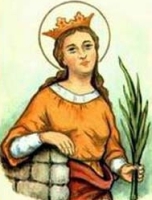
Dolcissima
Virgin martyr. Nothing else is known about her for sure, but her name has been entwined with the stories of many other martyrs.
• Sutri, Italy, city of
• Sutri, Italy, diocese of
https://catholicsaints.info/saint-dulcissima-of-sutri/
Marcianus
Father of Saint John. Imperial Roman senator. When Saint Abundius brought Saint John back from the dead, Marcian converted to Christianity on the spot and just as quickly executed for it. Martyr.
beheaded c.304 at Rome
Civita Castellana, Viterbo, Italy
https://catholicsaints.info/saint-marcian-the-senator/
• Dominic Shibioge
• Dominicus....
Dominican lay tertiary. Sheltered missionaries during the persecutions in Japan. Martyr.
Nagasaki, Japan
beheaded on 16 September 1628 at Nagasaki, Japan
7 May 1867 by Pope Pius IX
https://catholicsaints.info/blessed-dominic-shobyoye/
Married lay man. Father of Blessed Paul Himonoya. Convert. Member of the Lay Dominican tertiary. Ordered by authorities to renounce his faith; he refused. Martyr.
Japanese
beheaded on 16 September 1628 at Nagasaki, Japan
7 May 1867 by Pope Pius IX
https://catholicsaints.info/blessed-michael-himonoya/
Deacon in Rome, Italy. Arrested with Saint Abundius for refusing to sacrifice to Hercules. Tortured at Mammertine prison, and condemned to death for their Christianity during the persecutions of Diocletian. Martyred.
beheaded c.304 at Rome, Italy
https://catholicsaints.info/saint-abundantius-of-rome/
Son of Blessed Michael Himonoya. Dominican tertiary. Ordered by authorities to renounce his faith; he refused. Martyr.
Japanese
beheaded in 1628 at Nagasaki, Japan
7 May 1867 by Pope Pius IX
https://catholicsaints.info/blessed-paul-himonoya/
Servodidio, Servusdeus, Serviodeo, Abdallh
Servant and spiritual student of Saint Rogellus of Cordoba, and murdered by Moors with him for opposing Islam. Martyr.
852 at Cordoba, Spain
https://catholicsaints.info/saint-servus-dei/
Rogatus
Monk in Spain. After preaching against Islam, he and his student, Saint Servus Dei, were murdered by Moors. Martyr.
852 at Cordoba, Spain
https://catholicsaints.info/saint-rogellus-of-cordoba/
Woman in 1st century Phrygia, Asia Minor. Convert, brought to Christianity by Saint Paul the Apostle. Imprisoned, tortured and martyred in the persecutions of Domitian.
beheaded in 1st century Heraclea, Thrace
https://catholicsaints.info/saint-sebastiana/
Monk at the monastery of Huerta, Castile, Spain. Bishop of Sigüenza, Spain for several years before finally retiring back to his monastery.
1213 of natural causes
https://catholicsaints.info/blessed-martin-of-huerta/
A convert, she was imprisoned and tortured during the persecutions of Diocletian while still a neophyte. Baptized in prison. Martyr.
c.300 in Rome, Italy
https://catholicsaints.info/saint-geminianus-of-rome/
Monk. Spiritual student of Saint Humbert of Pelagius at Maroilles Abbey near Cambrai, France. Abbot of Maroilles.
c.680
https://catholicsaints.info/saint-cunibert-of-maroilles/
Married. Widow. Tortured and martyred at age 75 in the persecutions of Diocletian.
c.300 in Rome, Italy
https://catholicsaints.info/saint-lucy-of-rome-16-september/
Abbot of Saint Peter's Abbey in Perugia, Italy.
1026
https://catholicsaints.info/saint-stephen-of-perugia/
Benedictine abbot at Maroilles, diocese of Cambrai, France.
680 of natural causes
https://catholicsaints.info/saint-curcodomus/
Four Christian men martyred together, date unknown - Alexander, Felix, Papias and Victor.
on the Via Nomentana outside Rome, Italy
https://catholicsaints.info/martyrs-of-the-via-nomentana/
Thousands of people were murdered in the anti-Catholic persecutions of the Spanish Civil War from 1934 to 1939. I have pages on each of them, but in most cases I have only found very minimal information. They are available on the CatholicSaints.Info site through these links:
• Blessed Antonio Martínez García
• Blessed Ignasi Casanovas Perramón
• Blessed Manuel Ferrer Jordá
• Blessed Pablo Martínez Robles
• Blessed Salvador Ferrer Cardet
• Martyrs of Maranza
• Innocenza
• Priscus of Nocera
• Romolo
CatholicSaints.Info Portable Edition